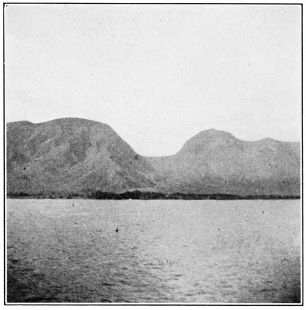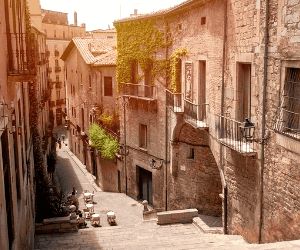Revisited
Legends of Maui - Maui Snaring the Sun

|
[Editor's note: This article is a reprint from "Legends of Ma-Ui, a Demi God of Polynesia and of his Mother Hina" by W. D. Westervelt. It was published in 1910. ] Maui is a demi god. The Maui story probably contains a larger number of unique and ancient myths than that of any other legendary character in the mythology of any nation. The Maui legends form one of the strongest links in the mythological chain of evidence which binds the scattered inhabitants of the Pacific into one nation.  Iao Mountain From the Sea
"Maui became restless and fought the sun A very unique legend is found among the widely-scattered Polynesians. The story of Maui's "Snaring the Sun" was told among the Maoris of New Zealand, the Kanakas of the Hervey and Society Islands, and the ancient natives of Hawaii. The Samoans tell the same story without mentioning the name of Maui. They say that the snare was cast by a child of the sun itself. The Polynesian stories of the origin of the sun are worthy of note before the legend of the change from short to long days is given. The Tongan Islanders, according to W. W. Gill, tell the story of the origin of the sun and moon. They say that Vatea (Wakea) and their ancestor Tongaiti quarreled concerning a child--each claiming it as his own. In the struggle the child was cut in two. Vatea squeezed and rolled the part he secured into a ball and threw it away, far up into the heavens, where it became the sun. It shone brightly as it rolled along the heavens, and sank down to Avaiki (Hawaii), the nether world. But the ball came back again and once more rolled across the sky. Tongaiti had let his half of the child fall on the ground and lie there, until made envious by the beautiful ball Vatea made. At last he took the flesh which lay on the ground and made it into a ball. As the sun sank he threw his ball up into the darkness, and it rolled along the heavens, but the blood had drained out of the flesh while it lay upon the ground, therefore it could not become so red and burning as the sun, and had not life to move so swiftly. It was as white as a dead body, because its blood was all gone; and it could not make the darkness flee away as the sun had done. Thus day and night and the sun and moon always remain with the earth. The legends of the Society Islands say that a demon in the west became angry with the sun and in his rage ate it up, causing night. In the same way a demon from the east would devour the moon, but for some reason these angry ones could not destroy their captives and were compelled to open their mouths and let the bright balls come forth once more. In some places a sacrifice of some one of distinction was needed to placate the wrath of the devourers and free the balls of light in times of eclipse. The moon, pale and dead in appearance, moved slowly; while the sun, full of life and strength, moved quickly. Thus days were very short and nights were very long. Mankind suffered from the fierceness of the heat of the sun and also from its prolonged absence. Day and night were alike a burden to men. The darkness was so great and lasted so long that fruits would not ripen. After Maui had succeeded in throwing the heavens into their place, and fastening them so that they could not fall, he learned that he had opened a way for the sun-god to come up from the lower world and rapidly run across the blue vault. This made two troubles for men--the heat of the sun was very great and the journey too quickly over. Maui planned to capture the sun and punish him for thinking so little about the welfare of mankind. As Rev. A. O. Forbes, a missionary among the Hawaiians, relates, Maui's mother was troubled very much by the heedless haste of the sun. She had many kapa-cloths to make, for this was the only kind of clothing known in Hawaii, except sometimes a woven mat or a long grass fringe worn as a skirt. This native cloth was made by pounding the fine bark of certain trees with wooden mallets until the fibres were beaten and ground into a wood pulp. Then she pounded the pulp into thin sheets from which the best sleeping mats and clothes could be fashioned. These kapa cloths had to be thoroughly dried, but the days were so short that by the time she had spread out the kapa the sun had heedlessly rushed across the sky and gone down into the under-world, and all the cloth had to be gathered up again and cared for until another day should come. There were other troubles. "The food could not be prepared and cooked in one day. Even an incantation to the gods could not be chanted through ere they were overtaken by darkness." This was very discouraging and caused great suffering, as well as much unnecessary trouble and labor. Many complaints were made against the thoughtless sun. Maui pitied his mother and determined to make the sun go slower that the days might be long enough to satisfy the needs of men. Therefore, he went over to the northwest of the island on which he lived. This was Mt. Iao, an extinct volcano, in which lies one of the most beautiful and picturesque valleys of the Hawaiian Islands. He climbed the ridges until he could see the course of the sun as it passed over the island. He saw that the sun came up the eastern side of Mt. Haleakala. He crossed over the plain between the two mountains and climbed to the top of Mt. Haleakala. There he watched the burning sun as it came up from Koolau and passed directly over the top of the mountain. The summit of Haleakala is a great extinct crater twenty miles in circumference, and nearly twenty-five hundred feet in depth. There are two tremendous gaps or chasms in the side of the crater wall, through which in days gone by the massive bowl poured forth its flowing lava. One of these was the Koolau, or eastern gap, in which Maui probably planned to catch the sun. Mt. Hale-a-ka-la of the Hawaiian Islands means House-of-the-sun. "La," or "Ra," is the name of the sun throughout parts of Polynesia. Ra was the sun-god of ancient Egypt. Thus the antiquities of Polynesia and Egypt touch each other, and today no man knows the full reason thereof. The Hawaiian legend says Maui was taunted by a man who ridiculed the idea that he could snare the sun, saying, "You will never catch the sun. You are only an idle nobody." Maui replied, "When I conquer my enemy and my desire is attained, I will be your death." After studying the path of the sun, Maui returned to his mother and told her that he would go and cut off the legs of the sun so that he could not run so fast. His mother said: "Are you strong enough for this work?" He said, "Yes." Then she gave him fifteen strands of well-twisted fiber and told him to go to his grandmother, who lived in the great crater of Haleakala, for the rest of the things in his conflict with the sun. She said: "You must climb the mountain to the place where a large wiliwili tree is standing. There you will find the place where the sun stops to eat cooked bananas prepared by your grandmother. Stay there until a rooster crows three times; then watch your grandmother go out to make a fire and put on food. You had better take her bananas. She will look for them and find you and ask who you are. Tell her you belong to Hina." When she had taught him all these things, he went up the mountain to Kaupo to the place Hina had directed. There was a large wiliwili tree. Here he waited for the rooster to crow. The name of that rooster was Kalauhele-moa. When the rooster had crowed three times, the grandmother came out with a bunch of bananas to cook for the sun. She took off the upper part of the bunch and laid it down. Maui immediately snatched it away. In a moment she turned to pick it up, but could not find it. She was angry and cried out: "Where are the bananas of the sun?" Then she took off another part of the bunch, and Maui stole that. Thus he did until all the bunch had been taken away. She was almost blind and could not detect him by sight, so she sniffed all around her until she detected the smell of a man. She asked: "Who are you? To whom do you belong?" Maui replied: "I belong to Hina." "Why have you come?" Maui told her, "I have come to kill the sun. He goes so fast that he never dries the tapa Hina has beaten out." The old woman gave a magic stone for a battle axe and one more rope. She taught him how to catch the sun, saying: "Make a place to hide here by this large wiliwili tree. When the first leg of the sun comes up, catch it with your first rope, and so on until you have used all your ropes. Fasten them to the tree, then take the stone axe to strike the body of the sun." Maui dug a hole among the roots of the tree and concealed himself. Soon the first ray of light--the first leg of the sun--came up along the mountain side. Maui threw his rope and caught it. One by one the legs of the sun came over the edge of the crater's rim and were caught. Only one long leg was still hanging down the side of the mountain. It was hard for the sun to move that leg. It shook and trembled and tried hard to come up. At last it crept over the edge and was caught by Maui with the rope given by his grandmother. The Hawaiian legend says Maui was taunted by a man who ridiculed the idea that he could snare the sun, saying, "You will never catch the sun. You are only an idle nobody." When the sun saw that his sixteen long legs were held fast in the ropes, he began to go back down the mountain side into the sea. Then Maui tied the ropes fast to the tree and pulled until the body of the sun came up again. Brave Maui caught his magic stone club or axe, and began to strike and wound the sun, until he cried: "Give me my life." Maui said: "If you live, you may be a traitor. Perhaps I had better kill you." But the sun begged for life. After they had conversed a while, they agreed that there should be a regular motion in the journey of the sun. There should be longer days, and yet half the time he might go quickly as in the winter time, but the other half he must move slowly as in summer. Thus men dwelling on the earth should be blessed. Another legend says that he made a lasso and climbed to the summit of Mt. Haleakala. He made ready his lasso, so that when the sun came up the mountain side and rose above him he could cast the noose and catch the sun, but he only snared one of the sun's larger rays and broke it off. Again and again he threw the lasso until he had broken off all the strong rays of the sun. Then he shouted exultantly, "Thou art my captive; I will kill thee for going so swiftly." Then the sun said, "Let me live and thou shalt see me go more slowly hereafter. Behold, hast thou not broken off all my strong legs and left me only the weak ones?" So the agreement was made, and Maui permitted the sun to pursue his course, and from that day he went more slowly. Maui returned from his conflict with the sun and sought for Moemoe, the man who had ridiculed him. Maui chased this man around the island from one side to the other until they had passed through Lahaina (one of the first mission stations in 1828). There on the seashore near the large black rock of the legend of Maui lifting the sky he found Moemoe. Then they left the seashore and the contest raged up hill and down until Maui slew the man and "changed the body into a long rock, which is there to this day, by the side of the road going past Black Rock." |
| Revisited - Maui Snaring the Sun | ||||
| Writer: | W. D. Westervelt | |||
| Images: | ||||
| ||||
| Sources: | ||||
| ||||
All images are Copyright - CC BY-SA (Creative Commons Share Alike) by their respective owners, except for Petey, which is Public Domain (PD) or unless otherwise noted.
comments powered by Disqus


















